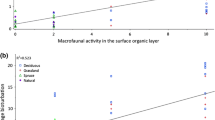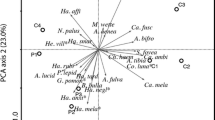Abstract
On a study site in the Lusatian lignite mining region (Germany), sandy mine spoil was ameliorated with either sewage sludge, compost or mineral fertilizer. Plots were sown with the grass Secale multicaule and planted with pine seedlings except for a control that was not meliorated and not revegetated. Pitfall catches of ground beetles in 1996/97 yielded high numbers of species and individuals directly after revegetation. The dominant beetles were xerophilic species, known to prefer open sandy sites. Catches in different plots were positively correlated with the amount of vegetation cover and declined as follows: amelioration with sewage sludge > compost > mineral fertilizer > untreated control. Even beetles characteristic of open sandy sites showed a distinct preference for plots with high vegetation cover treated with organic waste. For the dominant species, an attraction to shelter and a more balanced, humid microclimate is assumed. A year-to-year comparison showed an increase in beetles typical of dry grasslands and ruderal sites in the second year, while characteristic species of open sandy sites decreased. Application of organic waste combined with revegetation led to an immediate increase in beetle numbers. In the long term, revegetation would be expected to reduce suitable habitats for endangered ground beetles which prefer open sites with poor sandy soils.
Similar content being viewed by others
References
Barndt D, Brase S, Glauche M, Gruttke H, Kegel B, Platen R and Winkelmann H 1991 Die Laufkäferfauna von Berlin (West)-mit Kennzeichnung und Auswertung der verschollenen und gefährdeten Arten (Rote Liste, 3. Fassung). In Rote Listen der gefährdeten Pflanzen und Tiere in Berlin. Eds A Auhagen, R Platen and H Sukopp. Landschaftsentwicklung und Umweltforschung Sonderheft S 6 pp 243–275, Berlin.
Basedow T 1994 Phenology and egg production in Agonum dorsale and Pterostichus melanarius (Col., Carabidae) in winter wheat fields of different growing intensity in Northern Germany. In Carabid beetles: Ecology and evolution. Eds K Desender, M Dufrêne, M Loreau, M L Luff and J P Maelfait. pp 101–107. Kluwer Academic Publishers, Dordrecht.
Cardwell C, Hassall M and White P 1994 Effects of headland management on carabid beetle communities in Breckland cereal fields. Pedobiologia 38, 50–62.
Dunger W 1989 The return of soil fauna to coal mined areas in the German Democratic Republic. In Animals in primary succession. Ed. J D Majer. pp 307–337. Cambridge University Press, Cambridge.
Dunger W 1998a Ergebnisse langjähriger Untersuchungen zur faunistischen Besiedlung von Kippböden. In Braunkohlentagebau und Rekultivierung. Ed. W Pflug. pp 625–634. Springer-Verlag, Berlin.
Dunger W 1998b Immigration, Ansiedlung und Primärsukzession der Bodenfauna auf jungen Kippböden. In Braunkohlentagebau und Rekultivierung. Ed. W Pflug. pp 635–644. Springer-Verlag, Berlin.
Goldschmidt H and Toft S 1997 Variable degrees of granivory and phytophagy in insectivorous carabid beetles. Pedobiologia 41, 521–525.
Greenslade P J M 1964 Pitfall trapping as a method for studying populations of Carabidae (Coleoptera). J. Anim. Ecol. 33, 301–310.
Haag C and Depenbusch M 1995 Carabiden auf forstlichen Rekultivierungsflächen des rheinischen Braunkohlentagebaus: Besiedlung, Reproduktion und Sukzession. Mitt. Dtsch. Gesellsch. Allg. Angew. Entomol. 9, 727–731.
Heijerman T and Turin H 1994 Towards a method for biological assessment of habitat quality using carabid samples (Coleoptera, Carabidae). In Carabid beetles: Ecology and evolution. Eds K Desender, M Dufrêne, M Loreau, M L Luff and J-P Maelfait. pp 305–312. Kluwer Academic Publishers, Dordrecht.
Heijkal J 1985 The development of a carabid fauna (Coleoptera, Carabidae) on spoil banks under conditions of primary succession. Acta entomol. bohemoslov. 82, 321–346.
Hengeveld R 1980 Polyphagy, oligophagy and food specialization in ground beetles (Coleoptera, Carabidae). Neth. J. Zool. 30, 564–584.
Heydemann B 1957 Die Biotopstruktur als Raumwiderstand und Raumfülle für die Tierwelt. Verh. Dtsch. Zool. Gesellsch. 50, 332–347.
Honek A 1988 The effect of crop density and microclimate on pitfall trap catches of Carabidae, Staphylinidae (Coleoptera), and Lycosidae (Araneae) in cereal fields. Pedobiologia 32, 233–242.
Humphreys I C and Mowat D J 1994 Effects of some organic treatments on predators (Coleoptera: Carabidae) of Cabbage Root Fly, Delia radicum (L.) (Diptera: Anthomyiidae), and on alternative prey species. Pedobiologia 38, 513–518.
Hüttl R F 1998 Ecology of post-mining landscapes in Lusatia, Germany. Environmental Science and Policy 1, 129–135.
Kielhorn K-H, Keplin B and Hüttl R F 1998 Entwicklung von Artenzusammensetzung und Aktivitätsdichte in Carabidenzönosen forstlich rekultivierter Tagebauflächen. Verh. Gesellsch. Ökol. 28, 301–306.
Kobel-Lamparski A, Lamparski F and Peter B 1985 Die Wirkung von Klärschlamm auf Bodenfauna und Struktur des Oberbodens eines Buchenwaldes. Mitt. Ver. Forstl. Standortskunde Forstpflanzenzüchtung 31, 13–30.
Larsen K J, Purrington F F, Brewer S R and Taylor D H 1996 In-fluence of sewage sludge and fertilizer on the ground beetle (Coleoptera: Carabidae) fauna of an old-field community. Environ. Entomol. 25, 452–459.
Lindroth C H 1986 The Carabidae (Coleoptera) of Fennoskandia and Denmark. Fauna Entomologica Scandinavia 15, part 2. Brill/Scandinavian Science Press, Leiden. 497 p.
Luff M L 1987 Biology of polyphagous ground beetles in agriculture. Agric. Zool. Rev. 2, 237–278.
Mader H J 1986 The succession of carabid species in a brown coal mining area and the influence of afforestation. In Carabid beetles: Their adaptations and dynamics. Eds P J Den Boer, M L Luff, D Mossakowski and F Weber. pp 497–508. Fischer-Verlag, Stuttgart.
Mitchell B 1963 Ecology of two carabid beetles, Bembidion lampros (Herbst) and Trechus quadristriatus (Schrank) II. Studies on populations of adults in the field, with special reference to the technique of pitfall trapping. J. Anim. Ecol. 32, 377–392.
Müller J K 1984 Die Bedeutung der Fallenfang-Methode für die Lösung ökologischer Fragestellungen. Zool. Jahrb. Syst. 111, 281–305.
Müller-Motzfeld G 1989 Laufkäfer (Coleoptera: Carabidae) als pedobiologische Indikatoren. Pedobiologia 33, 145–153.
Neumann U 1971 Die Sukzession der Bodenfauna (Carabidae (Coleoptera), Diplopoda und Isopoda) in den forstlich rekultivierten Gebieten des Rheinischen Braunkohlenreviers. Pedobiologia 11, 193–226.
Parmenter R R and MacMahon J A 1987 Early successional patterns of arthropod recolonization on reclaimed strip mines in Southwestern Wyoming: The ground-dwelling beetle fauna (Coleoptera). Environ. Entomol. 16(1) 168–175.
Pietraszko R and de Clercq R 1982 Influence of organic matter on epigeic arthropods. Med. Fac. Landbouww. Rijksuniv. Gent 47/2, 721–728.
Pimentel D and Warneke A 1989 Ecological effects of manure, sewage sludge and other organic wastes on arthropod populations. Agric. Zool. Rev. 3, 1–30.
Purvis G and Curry J P 1984 The influence of weeds and farmyard manure on the activity of Carabidae and other ground-dwelling arthropods in a sugar beet crop. J. appl. Ecol. 21, 271–283.
Skambracks D, Stengele U and Topp W 1997 Verteilungsmuster von Laufkäfern (Carabidae) auf der Außenkippe Sophienhöhe. Mitt. Dtsch. Bodenkundl. Gesellsch. 83, 211–213.
Speight M R and Lawton J H 1976 The influence of weed-cover on the mortality imposed on artificial prey by predatory ground beetles in cereal fields. Oecologia 23, 211–223.
Thiele H-U 1964 Experimentelle Untersuchungen über die Ursachen der Biotopbindung bei Carabiden. Z. Morphol. Ökol. Tiere 53, 387–452.
Thiele H-U 1977 Carabid beetles in their environments. Springer, Berlin. 369 p.
Topp W, Gemesi O, Grüning C, Tasch P and Zhou H-Z 1992 Forstliche Rekultivierung mit Altwaldboden im Rheinischen Braunkohlenrevier-Die Sukzession der Bodenfauna. Zool. Jb. Syst. 119, 505–533.
Trautner J 1992 Laufkäfer. Methoden der Bestandsaufnahme und Hinweise für die Auswertung bei Naturschutz-und Eingriffsplanungen. In Arten-und Biotopschutz in der Planung: Methodische Standards zur Erfassung von Tierartengruppen. Ed. J Trautner. Ökologie in Forschung und Anwendung 5pp 145–162. Margraf, Weikersheim.
Trautner J, Müller-Motzfeld G and Bräunicke M 1997 Rote Liste der Sandlaufkäfer und Laufkäfer Deutschlands (Coleoptera: Cicindelidae et Carabidae). Naturschutz und Landschaftsplanung 29, 261–273.
Vermeulen R 1994 The effects of different vegetation structures on the dispersal of carabid beetles from poor sandy heaths and grasslands. In Carabid beetles: Ecology and evolution. Eds K Desender, M Dufrêne, M Loreau, M L Luff and J-P Maelfait. pp 387–392. Kluwer Academic Publishers, Dordrecht.
Vetterlein D, Heinkele T, Schaaf W, Waschkies C, Meyer G, Weiß U and Hüttl R F 1997 Initiale Prozesse der Stoffumsetzungen auf reststoffmeliorierten Kippstandorten. a) Zielsetzung des Gesamtprojektes, Hypothesen, Standorte, Versuchsanlage. Mitt. Dtsch. Bodenkundl. Gesellsch. 83, 223–226.
Vogel J and Dunger W 1991 Carabiden und Staphyliniden als Besiedler rekultivierter Tagebau-Halden in Ostdeutschland. Abh. Ber. Naturkundemus. Görlitz 65(3), 1–31.
Vowinkel K 1990 Besiedlung unterschiedlich rekultivierter Salz-, Asche-und Braunkohlehalden durch epigäische Arthropoden, unter besonderer Berücksichtigung der Carabidae. Mitt. Ergänzungsstudium Ökol. Umweltsicherung 15, 1–128.
Wallin H 1985 Spatial and temporal distribution of some abundant carabid beetles (Coleoptera: Carabidae) in cereal fields and adjacent habitats. Pedobiologia 28, 19–34.
Weidemann G 1972 Die Stellung epigäischer Raubarthropoden im Ökosystem Buchenwald. Verh. Dtsch. Zool. Gesellsch. 65, 106–116.
Rights and permissions
About this article
Cite this article
Kielhorn, K.H., Keplin, B. & Hüttl, R.F. Ground beetle communities on reclaimed mine spoil: Effects of organic matter application and revegetation. Plant and Soil 213, 117–125 (1999). https://doi.org/10.1023/A:1004508317091
Issue Date:
DOI: https://doi.org/10.1023/A:1004508317091




